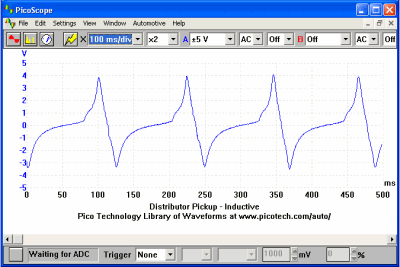 |
This is a good waveform |

 View larger image View larger image
 Download this waveform file for use with PicoScope Download this waveform file for use with PicoScope
Distributor Inductive Pick-up (Engine Cranking) Waveform Notes
This particular type of pick-up generates its own signal and therefore does not require a voltage supply to power it. Recognisable by its two electrical connections, the pick-up is used as a signal to trigger the ignition amplifier or Electronic Control Module (ECM).
This type of pick-up could be described as a small alternator because the output voltage rises as the metal rotor approaches the winding, sharply dropping through zero volts as the two components are aligned and producing a voltage in the opposite phase as the rotor passes. The waveform is known as a sinewave.
The cranking voltage produced by the pick-up will be determined by several factors, these being:
- Cranking speed - the voltage produced will be approximately 2 to 3 volts when cranking at a speed of around 250 RPM
- The proximity of the metal rotor to the pick-up winding. An average air gap will be in the order of 8 to 14 thou, a larger air gap will reduce the strength of the magnetic field seen by the winding and the output voltage will be subsequently reduced.
- The strength of the magnetic field offered by the magnet. The strength of this magnetic field determines the effect it has as it ‘cuts’ through the windings and the output voltage will be reduced accordingly.
A difference between the positive and the negative voltages may also be apparent as the negative side of the sinewave is sometimes attenuated when connected to the amplifier circuit, but will produce perfect AC when disconnected and tested under cranking conditions. The majority of pick-ups will produce approximately 3 volts peak to peak and this figure is widely accepted to be the minimum requirement to trigger the amplifier / ECM, this voltage will also however be manufacturer and model specific and may differ slightly.
汽车诊断 | 汽车诊断仪 | 汽车故障诊断仪 | 汽车测试仪 | 汽车分析仪 | 汽车诊断示波器 | 汽车电路测试仪 | 汽车电路分析仪 | 发动机分析仪 | 发动机综合分析仪 | 发动机检测中心 | 点火分析仪 | 点火测试仪 | 汽车传感器测试仪 | CAN总线示波器 | LIN总线示波器 | 汽车故障记录仪 | 汽车传感器分析仪 | 汽车检测仪 | 喷油嘴测试仪 | 点火线圈测试仪 | 蓄电池测试仪 | 发电机测试仪 | 起动机测试仪 | ABS传感器测试仪 | ECU测试仪 | ECM测试仪 | 进气真空/压力测试仪 | 排气压力测试仪 | 汽车技术培训 | 爆震传感器测试仪 | 缺火测试仪 | 缺缸测试仪 | 线路测试仪 | 引出线 | 汽车数字示波器 | 真空传感器 | 高压感应测试头 | 无分电器点火测试头 | 独立点火(COP)感应测试头 | 漏电测试仪 | 气缸相对压缩测试 | 电脑测试仪 | 发动机控制器测试仪 | 泄漏测试仪 | 荧光检漏 | 超声波检漏 | 汽车数字万用表 | 电流钳表 | 电流勾表 | 点火正时灯 |



